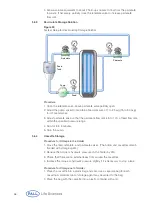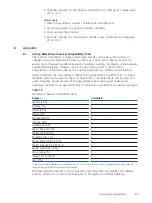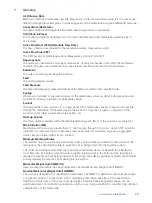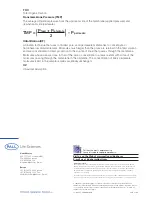
44
Equation 7
Water Permeability Calculation
5.4.3
Normalize the Water Permeability
Normalize the water permeability to a temperature of 20 °C using Equation 9:
Calculation for Membrane Recovery and the temperature correction factor (TCF
20 °C
)
in Table 11.
Equation 8
Calculation for Normalized Water Permeability
5.4.4
Determine the Membrane Recovery
Calculate the membrane recovery using Equation 9: Calculation for Membrane
Recovery.
Equation 9
Calculation for Membrane Recovery
5.4.5
Evaluate the Effectiveness of the Cleaning Regimen
For a new process, if membrane recovery is less than 100%, the cleaning regimen
should be repeated. This is to determine that the initial cleaning time at the selected
conditions was sufficient, and if not, to determine the appropriate number of cleaning
cycles or time required. If membrane recovery has improved after the second
cleaning cycle, a third cycle should be performed. When no additional improvement
in recovery is achieved, you know the last cycle time had reached maximum effect
for the conditions used. You may then use one cleaning cycle for the established
time or two or more cycles of shorter duration to equal the desired time. Several
cycles may be preferred, especially if cleaning is done at an elevated temperature
and the system cannot maintain temperature of the cleaning fluid.
Studies altering conditions, cycle time, temperature, or reagent concentration should
be performed to evaluate the most effective cleaning protocol for your process.
Note: Between uses, membrane cassettes are typically stored in a caustic solution
(0.05 to 0.1 N NaOH). During this time, remaining foulants on the membrane may be
degraded and removed when the membrane cassettes are flushed prior to the next
use. As a result of membrane relaxation and additional cleaning during storage, it is
not unusual for the membrane recovery, measured after storage, to increase relative
to the membrane recovery measured immediately after cleaning.
5.5
Post-Use Air Integrity Test (optional)
Post-use air integrity tests are not usually performed on TFF cassettes. There are no
requirements, as with sterilizing grade filters, that the cassette must pass a post-use integrity
test. Usually analysis of results, including performing a mass balance to establish if there is
product loss and where the loss might be, is sufficient to establish that the system is working
satisfactorily. If you wish to determine post-use integrity, follow the procedure given in
Section 4.6.
Water Permability =
Permeate Flux Rate (LMH)
TMP
NWP Recovery =
x 100%
NWP
after cleaning
NWP
initial
NWP
20 °C
=
X TCF
20 °C
Permeate Flux Rate (LMH)
TMP








































